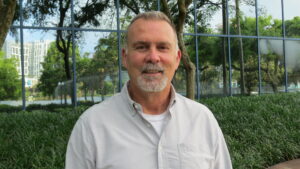
As a chief traffic operations designer for a world class architecture and engineering firm, Fred Weary understands the upside of using public transport as an alternative to sitting in heavy traffic.
“About 15 years ago, it got to a point where I was debating leaving my job because the commute on I-4 was too stressful for me,” he said.
For the first 10 years of his 25-year career, he drove solo from his Deltona neighborhood into downtown Orlando via I-4, five days a week. Weary now lives in DeLand and only drives occasionally since the inception of SunRail, Central Florida’s passenger train.
“I tried carpooling many years ago, rode the LYNX #200 bus for about six years, which was great for me at the time,” he continued. He eventually searched for a more consistent commuting alternative.
Today, Weary commutes via SunRail, and proudly asserts that he’s been a SunRail rider since its first day of operation in 2014.
“It will be interesting to see what SunRail does for their 10-year anniversary next year, and the opening of the DeLand station which recently had a groundbreaking ceremony.”
Five days a week, Weary drives to the nearest SunRail station in DeBary and boards his train. When he reaches downtown Orlando, Weary walks a leisurely half mile to his office building at Lake Eola.
When asked what he likes to do with his extra free time riding SunRail, Weary says, “Most of the time in the mornings I sleep because I get up so early. The train helps me catch up on sleep. On the ride back, sometimes I’ll read the newspaper or work on a pressing project. It’s great.”
Commuters are turning to alternative modes of transportation to relieve stress, help the environment, and save on fuel costs.
“My employer pays for my train pass, $112 a month, which is great.” Riding the train means he drives 1,000 fewer miles a month and saves $270 on gas. “It’s quite expensive to drive my current vehicle, so I enjoy riding the SunRail as a cost-effective alternative,” said Weary.
He also takes part in an employer-offered vitality program that incentivizes him to walk when he can to save on his health insurance with each step he takes.
Similarly, commuters can track their alternative route miles in the reThink Your Commute app, which offers a way for those that are health or savings-conscious to find carpool buddies, plan their bike route, or simply record SunRail miles to then earn rewards from local restaurants and more.
“When people find out that I’m commuting via SunRail, they ask questions, to see if they can also use it. My advice is to just try it for a week and see if it’s right for you,” said Weary.
For more information about SunRail, please visit https://SunRail.com/.

